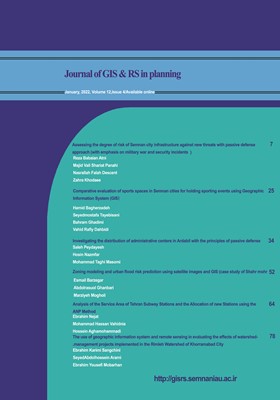The use of geographic information system and remote sensing in evaluating the effects of watershed management projects implemented in the Rimleh Watershed of Khorramabad City.
Subject Areas : Environmental planning
Ebrahim Karimi Sangchini
1
,
SeyedAbdolhossein Arami
2
,
Ebrahim Yousefi Mobarhan
3
![]()
1 - Assistant Professor, Soil Conservation and Watershed Management Research Department, Lorestan Agricultural and Natural Resources Research and Education Center, AREEO, Khorramabad, Iran.
2 - Assistant Professor, Forests and Rangelands Research Department, Khuzestan Agricultural and Natural Resources Research and Education Center, Agricultural Research Education and Extension Organization (AREEO), Ahvaz, Iran
3 - Soil Conservation and Watershed Management Research Institute, Semnan Agricultural and Natural Resources Research and Education Center, Agricultural Research, Education and Extension Organization (AREEO), Semnan, Iran.
Keywords: EPM model, Erosion and sedimentation, Production runoff, CN coefficient,
Abstract :
Evaluating the implemented watershed projects and providing a perspective of their performance results provide managers and decision-makers with appropriate information for long-term planning. Nowadays, by using powerful remote sensing software and geographic information system, the necessary calculations can be done with more accuracy and speed. The purpose of this research was to evaluate the effects of watershed management projects implemented in the Rimeleh Watershed using geographic information system and remote sensing in terms of erosion, sedimentation, and runoff. EPM model was used to predict erosion before and after the implementation of watershed projects. American Soil Conservation Society (SCS) curve number method was used to calculate the runoff before and after implementation of watershed management plans. The CN coefficient was calculated for two applications prepared in 1370 and the current one. The paired t-test was used to investigate the statistical difference between the difference in production runoff and the amount of erosion and sedimentation before and after the implementation of watershed projects. The amount of total annual erosion and sedimentation in current conditions have decreased by an average of 6793 cubic meters and 5712 tons, respectively, compared to before the implementation of watershed protection plans. The amount of difference in the volume of annual runoff between before the implementation of the plans and the current conditions is on average about 15256 cubic meters. The results of the paired t-test showed that the watershed protection measures implemented in the Rimeleh Watershed have been able to create a significant difference in reducing erosion, sedimentation and production runoff, and the general conclusion is that these measures have had a significant positive effect in reducing erosion, sedimentation, and production runoff.
_||_


